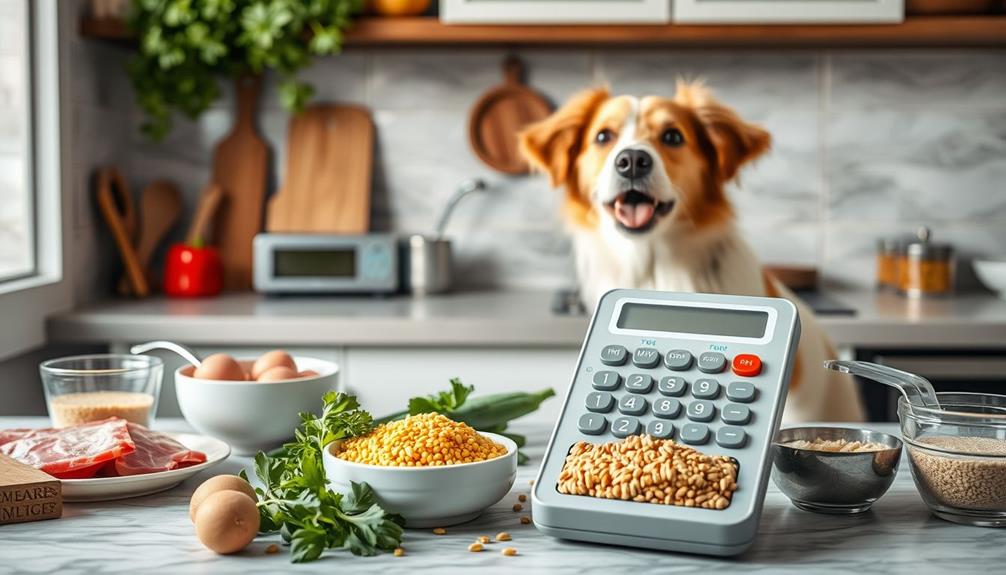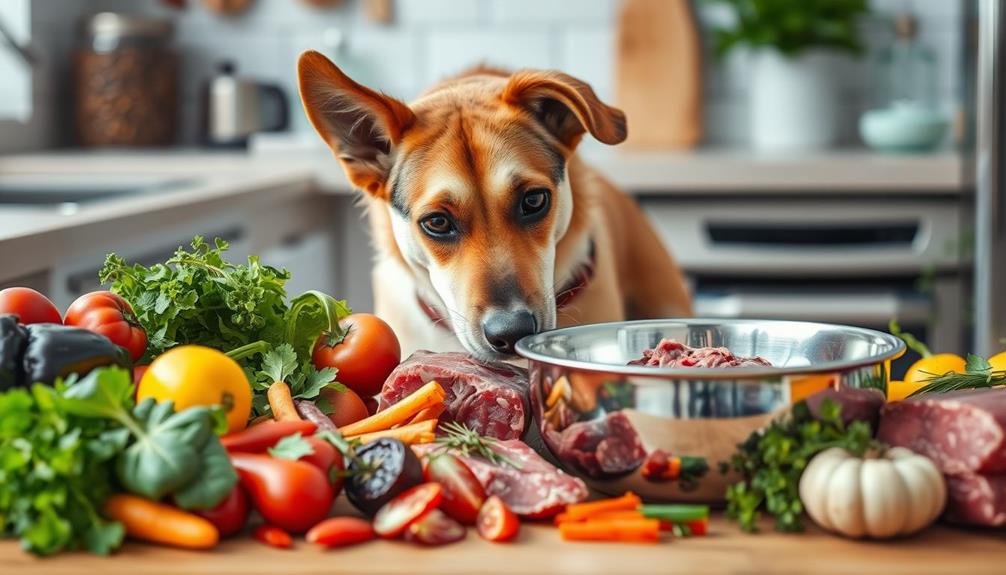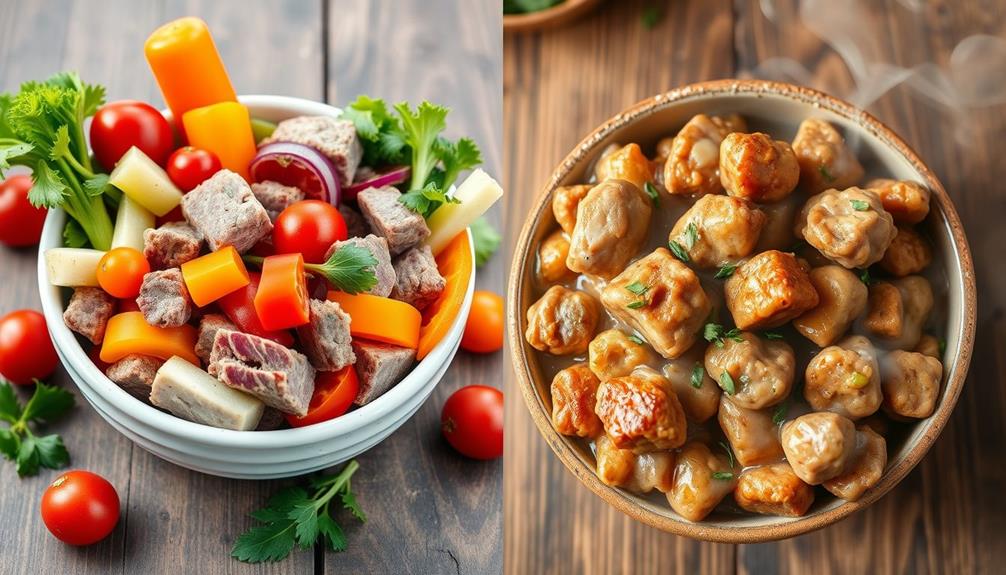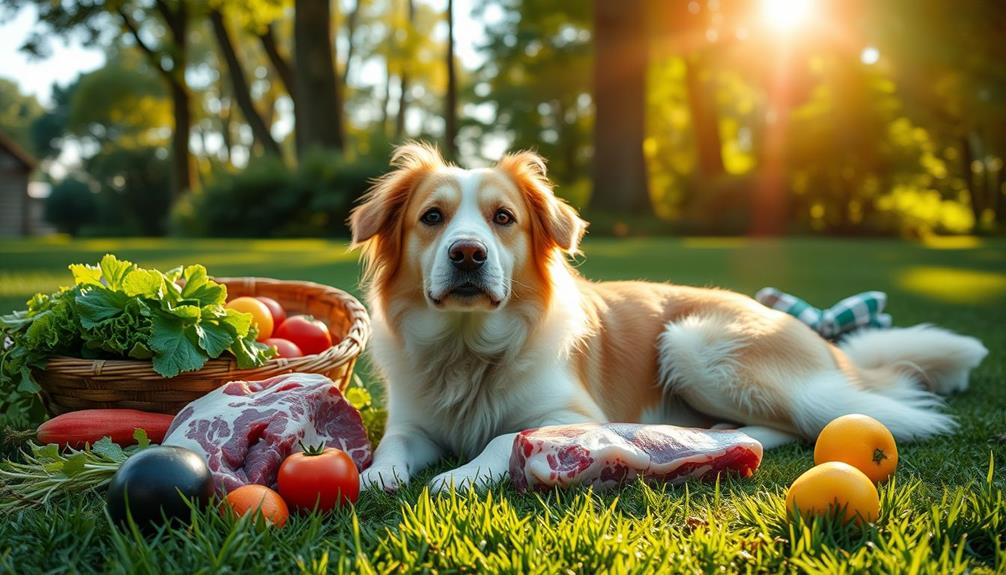To know how much raw food to feed your dog, start by determining their ideal weight. Generally, feed them 2% to 3% of this weight daily, adjusting based on their activity level—more active dogs need about 3% to 4%. It's crucial to maintain a balanced diet with quality ingredients, incorporating muscle meat, edible bones, organs, and veggies. Regularly monitor your dog's weight and adjust portions as needed. Utilizing a raw food calculator can simplify this process, providing tailored recommendations for your pup. Stick around to discover more about optimizing their diet and keeping them healthy! If you’re unsure about how to calculate the ideal portions for your dog, consider using a raw food calculator for my dog, which can take the guesswork out of meal planning. By inputting specific details about your dog, such as their weight, age, and activity level, the calculator can generate personalized feeding recommendations. This can help ensure that your furry friend receives the right balance of nutrients and maintains a healthy weight.
Key Takeaways
- Determine your dog's ideal weight and use it to calculate daily food intake, typically 2% to 3% of their body weight.
- Adjust food portions based on your dog's activity level, increasing to 3% to 4% for active dogs.
- Regularly monitor your dog's weight and health to ensure nutritional needs are being met effectively.
- Utilize a raw food calculator to tailor portion sizes and dietary requirements specific to your dog's needs.
- Focus on high-quality, locally sourced ingredients for better nutrient absorption and overall health benefits.
Understanding Raw Diet Benefits
When you switch to a raw diet for your dog, you'll quickly notice the benefits it brings to their health and appearance. Adult dogs thrive on raw food, which promotes shinier coats and healthier skin, enhancing their overall well-being.
Healthy dog snacks can complement a raw diet, providing variety and additional nutrients. Raw diets offer superior nutrient absorption compared to kibble, ensuring your furry friend gets essential vitamins and minerals efficiently.
Additionally, if your dog has food sensitivities or allergies, a raw diet can greatly improve their digestive health. You'll likely see a reduction in discomfort and digestive issues, leading to a happier, more comfortable pet.
The natural chewing that comes with feeding raw also supports dental health, helping to reduce plaque and tartar buildup, which is crucial for adult dogs.
Moreover, dogs on a raw diet often experience enhanced energy levels and vitality. This boost translates into a more active and playful lifestyle, allowing you to enjoy quality time together.
By choosing a raw diet, you're not just improving your dog's appearance; you're investing in their long-term health and happiness.
How to Calculate Portions
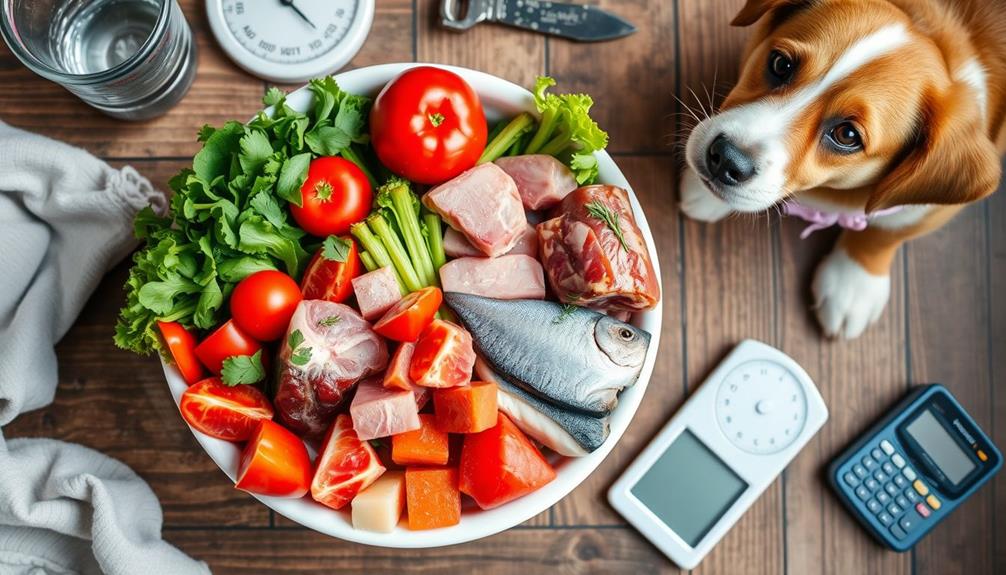
To calculate your dog's raw food portions, start with their ideal weight and use the formula to find the right daily intake.
It's important to take into account the quality of the raw food you're providing, as a balanced diet contributes considerably to your dog's overall health and well-being, similar to the care needed for small pets like hamsters, where proper diet guidelines are vital.
You'll also want to adjust these portions based on how active your dog is, since more active dogs may need more food.
Keeping an eye on their weight will help guarantee you're meeting their nutritional needs effectively.
Ideal Weight Calculation
Calculating the ideal raw food portions for your dog requires a straightforward approach to guarantee they receive the right nutrition.
It's also important to take into account factors such as your dog's age, breed, and any specific health conditions that may influence their dietary needs, as well as daily cranberry juice consumption which can impact overall health.
Start by determining your dog's ideal body weight, then use the formula: (Dog's weight) x 0.02 to 0.03. This will give you the daily food intake in pounds. For example, if your dog weighs 25 lbs, the ideal amount of raw food they should consume is approximately 0.5 lbs (8 oz) daily based on 2% of their body weight.
Keep in mind that more active dogs might need up to 3% of their body weight, while less active ones should stick closer to 2%.
Regularly monitoring your dog's weight is essential; this way, you can adjust their food portions accordingly to maintain the best health.
To simplify this process, think about using a raw feeding calculator. This tool helps tailor the amount of raw food to your dog's specific needs, ensuring they get the right nutrients to thrive.
Adjusting for Activity
Adjust your dog's raw food portions based on their activity level to guarantee they meet their energy needs. Raw feeding isn't just about the type of food; it's also about the right amount.
It's crucial to take into account your dog's overall health and any specific dietary needs they may have, such as those related to conditions like gout nutrition.
Here's how to adjust portions effectively:
- Start with the basics: Begin with 2% to 3% of your dog's ideal adult body weight as a baseline for feeding.
- Adjust for activity: For active dogs, increase portions to 3% to 4% of their body weight. Less active dogs may only need around 2% or less.
- Monitor weight: Regularly check your dog's weight. Initial weight loss during the changeover is often water weight, so focus on gradual adjustments for sustainable results.
- Use a calculator: Take advantage of a raw feeding calculator to input your dog's weight and activity level, ensuring you're meeting their specific needs.
Monitoring Your Dog's Health

Monitoring your dog's health during their shift to a raw diet is vital for guaranteeing they thrive on this new feeding regimen. Start by regularly checking your dog's weight to confirm they're maintaining an ideal body condition. This is especially important during the initial shift, as you might notice some weight loss, often due to water weight.
Additionally, keep in mind that development influenced by biological factors can also affect your dog's adaptation to diet changes.
Adjust their food intake based on their activity level; active dogs may need larger portions, while those who are less active might require smaller amounts. Aim to limit any weight loss to 1-2% per week to avoid health complications and maintain a balanced diet.
Keep a close eye on their overall well-being, as changes in energy levels, coat condition, and digestion can indicate how well they're adapting to their new diet.
Regular veterinary check-ups are vital during this period to monitor your dog's health and make adjustments to their raw food intake as necessary. By staying vigilant and proactive, you'll help guarantee that your dog enjoys all the benefits of a raw diet while remaining healthy and happy.
Importance of Ingredient Quality
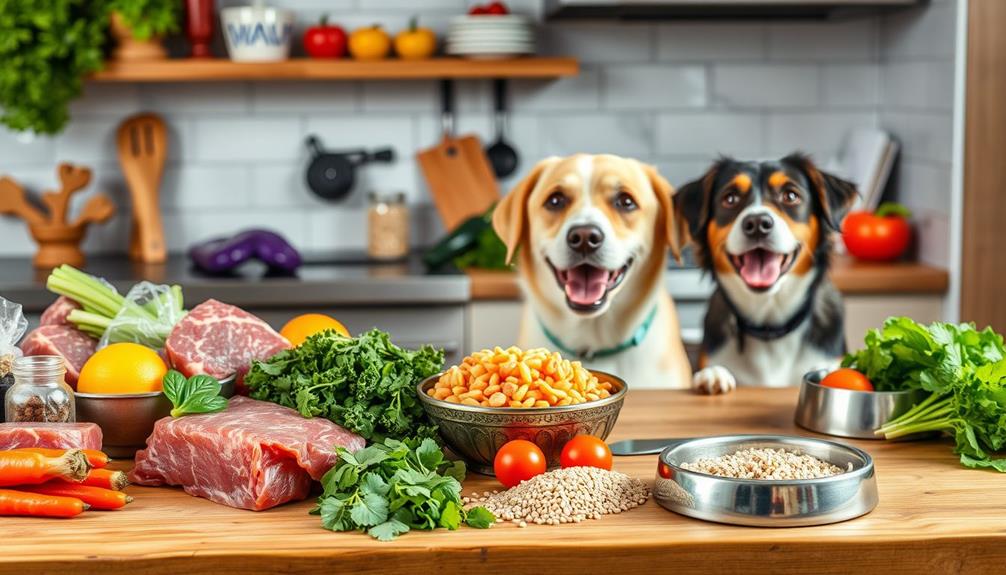
When feeding your dog raw food, the quality of ingredients is essential for their health and wellbeing.
High-quality protein sources, such as grass-fed meats or organic poultry, can greatly enhance your dog's diet. You'll want to assess the nutritional value, source local ingredients, and steer clear of any additives or preservatives.
This focus on quality not only boosts your dog's vitality but also supports a healthier lifestyle, including the benefits of essential oils for overall health.
Nutritional Value Assessment
To guarantee your dog thrives on a raw diet, the quality of ingredients you choose is essential. Conducting a nutritional value assessment helps confirm your dog's meals are safe, wholesome, and balanced.
Here are four key factors to evaluate when assessing your raw dog food ingredients:
- Source: Select ingredients that are locally sourced and free from antibiotics, hormones, and preservatives. This reduces the risk of harmful additives.
- Composition: Aim for a balanced diet of approximately 70-80% muscle meat, 10% edible bone, 5-7% liver and organs, and 7% vegetables. This ratio supports ideal health.
- Variety: Incorporate a diverse range of high-quality proteins, organs, and vegetables. A varied diet enhances the nutrient profile and prevents deficiencies.
- Regular Assessment: Continually assess the nutritional value of your ingredients. Raw diets can lack certain essential vitamins and minerals, so supplementation may be necessary.
Using a raw food calculator can help you determine the right proportions of muscle meat, edible bone, and organ meats to meet your dog's specific nutritional needs effectively.
Prioritize quality to confirm your pup flourishes!
Sourcing Local Ingredients
Sourcing local ingredients is essential for ensuring your dog receives the highest quality nutrition from a raw diet. Fresh, locally sourced ingredients enhance the nutritional value of your dog's meals. They're often free from antibiotics and added hormones, promoting a healthier diet. By prioritizing high-quality ingredients, you can reduce the risk of allergens and food sensitivities, leading to better overall health for your furry friend.
Here's a quick comparison of the benefits of sourcing local ingredients versus imported ones:
| Local Ingredients | Imported Ingredients | Benefits |
|---|---|---|
| Freshness | Often processed | Higher nutritional value |
| No antibiotics or hormones | Possible contamination | Healthier for your dog |
| Supports local economy | Supports distant suppliers | Community benefit |
| Transparency on sourcing | Limited information | Peace of mind |
| Better nutrient absorption | Reduced absorption | Improved health outcomes |
Utilizing high-quality, local ingredients not only contributes to your dog's well-being but also supports community economies. So, consider where your ingredients come from; it makes a significant difference in your dog's health!
Avoiding Additives and Preservatives
The quality of ingredients you choose for your dog's raw diet plays an important role in their overall health. By avoiding harmful additives and preservatives, you can guarantee your dog thrives on a nutritious and wholesome diet.
Prioritizing high-quality ingredients not only promotes better health but also aligns with the principle of budgeting for pet care by investing in your dog's long-term well-being.
Here are four reasons to focus on ingredient quality:
- Reduced Chemical Exposure: Choosing raw meals that are locally sourced and free from antibiotics minimizes your dog's risk of harmful chemical exposure.
- Enhanced Nutrient Absorption: High-quality raw dog food is rich in natural ingredients, leading to better nutrient absorption and improved skin and coat condition.
- Fewer Allergens: Raw diets generally contain fewer allergens and food sensitivities compared to traditional kibble, making them ideal for dogs with dietary restrictions.
- Improved Energy: Providing balanced meals without harmful additives supports your dog's dental health and boosts their energy levels.
Using the Raw Food Calculator
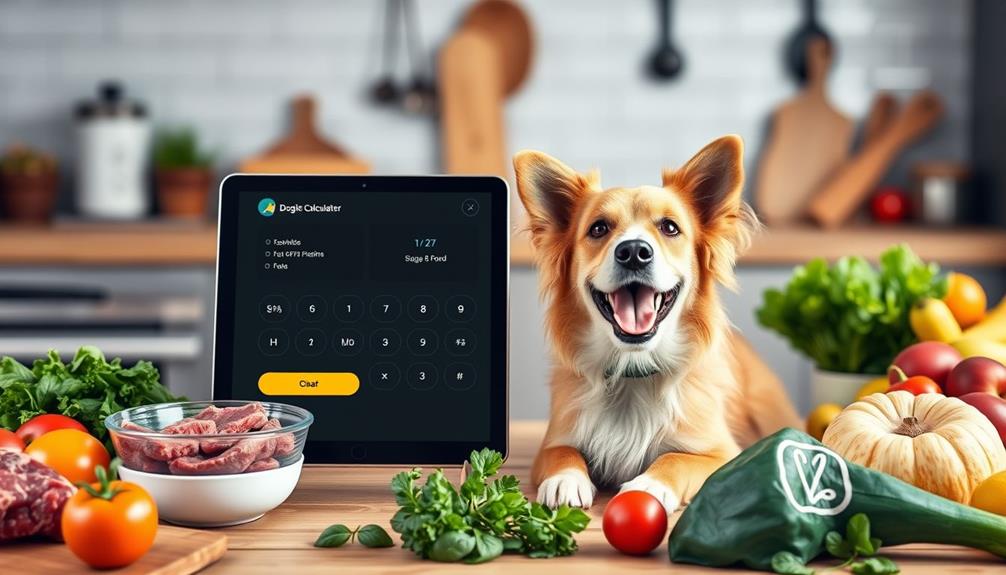
Using a Raw Food Calculator is a smart way to determine how much raw food your dog needs for a balanced diet. This tool helps you assess the right amount of food based on your dog's ideal weight and daily activity levels.
To get started, simply input your dog's weight and choose the percentage of their total diet that will consist of raw food, typically between 10% and 100%. Proper portioning is vital, similar to understanding tableware terminology for enhancing your dining experience.
Once you've made these selections, the Raw Food Calculator will provide a detailed breakdown of the necessary food components. You'll find recommendations for muscle meat (70-80%), edible bone (10%), and liver and organs (5%). This guarantees your dog receives the nutrients they require for peak health.
The calculator also caters to your preferences by offering daily intake calculations in multiple units, such as pounds, ounces, kilograms, or grams.
It's especially useful when adapting from dry to raw diets, as it helps adjust the amount of food based on your dog's response and weight management progress. By utilizing this tool, you can confidently provide your dog with a nutritious and balanced raw food diet.
Breed-Specific Feeding Guidelines

Understanding breed-specific feeding guidelines is essential for providing your dog with the right amount of raw food. Each breed has unique dietary needs based on size, activity level, and metabolism.
Additionally, being aware of financial considerations for elderly care can help pet owners budget for their dog's dietary requirements. Here are some key considerations to keep in mind:
- Size Matters: Larger breeds like the Alaskan Malamute may need between 680g to 900g daily, while smaller breeds like the Affenhuahua only require 40g to 100g.
- Daily Ranges: Breeds such as the Afador usually need 460g to 680g, while the American Bulldog can require anywhere from 540g to 1080g.
- Cost Variability: Feeding costs differ considerably; smaller breeds typically cost around £0.17 to £0.43 daily, while larger breeds, like the Boerboel, can range from £4.30 to £7.83.
- Monitor and Adjust: Regularly check your dog's weight and adjust portions as needed, since individual metabolic rates and activity levels can vary widely.
Tips for a Successful Transition
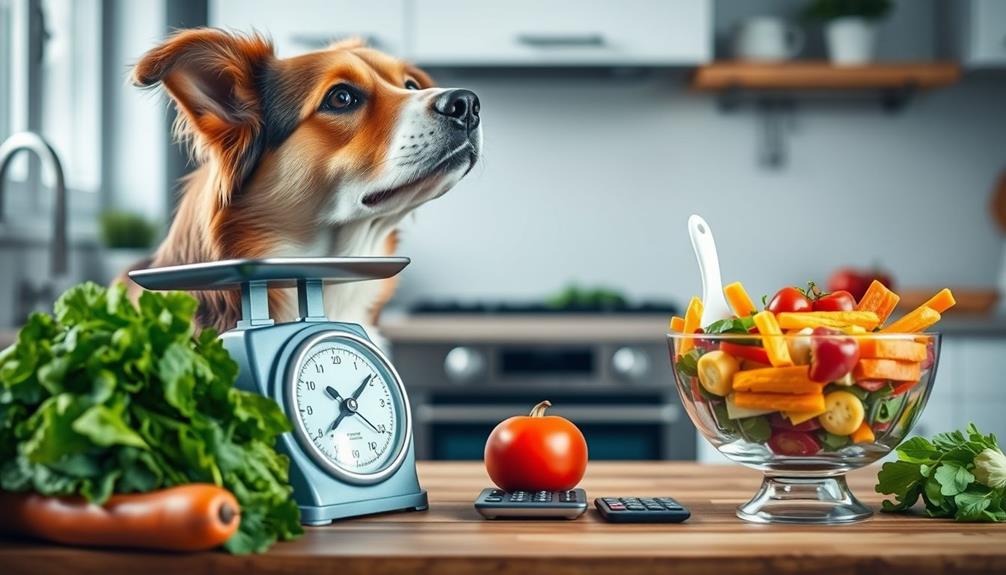
When shifting your dog to a raw food diet, a gradual approach makes all the difference. Start by introducing raw food slowly, aiming for about 20% of the diet as raw during the first week.
It's important to maintain proper piercing care and hygiene to avoid any complications, just as you'd with your dog's dietary shift. Gradually increase this to 100% by the end of the week to minimize any digestive upset.
It's essential to monitor your dog's weight closely during this adjustment. You should aim for a weight loss of no more than 1-2% per week, guaranteeing a healthy adjustment to the new diet.
Utilize a Dog Food Calculator to determine how much raw food to feed your dog based on their ideal weight, activity level, and dietary needs. Keep an eye on your dog for any signs of food sensitivities or allergies. If you notice any issues, adjust the types or portions of food accordingly.
Lastly, provide a balanced diet by incorporating muscle meat, edible bones, organs, and vegetables. This way, you're meeting all your dog's nutritional needs while adapting them to a raw food diet.
Following these tips can help make the process smoother and healthier for your furry friend.
Frequently Asked Questions
How Do I Calculate How Much Raw Food My Dog Needs?
To calculate your dog's raw food needs, multiply their ideal body weight by 2% to 3%. Adjust portions based on activity level, and monitor their weight to guarantee it stays within a healthy range.
How Much Raw Food Should I Feed My Dog Chart?
To determine how much raw food to feed your dog, consult a feeding chart based on their weight and breed. Adjust portions as needed to maintain their ideal weight and overall health throughout their life.
What Is the 80 10 10 Rule for Raw Dog Food?
Did you know that 80% of a dog's diet should be muscle meat? The 80/10/10 rule means you'll balance that with 10% edible bone and 10% organ meat for ideal health and energy.
How Do I Calculate How Much Food to Feed My Dog?
To calculate how much food to feed your dog, multiply their weight by 0.02 to 0.03. Adjust the portion according to their activity level and monitor their health for any necessary changes.
Conclusion
Feeding your dog a raw diet can be a rewarding journey, much like finding a hidden treasure. By understanding the benefits, calculating the right portions, and keeping an eye on your pup's health, you'll guarantee they thrive. Remember, quality ingredients matter, and using a raw food calculator can simplify the process. With breed-specific guidelines and a seamless shift, you'll be on your way to a healthier, happier dog. Embrace this adventure, and watch your furry friend flourish!

